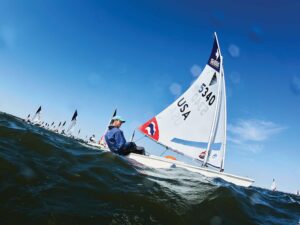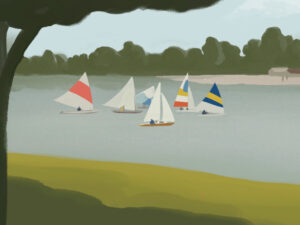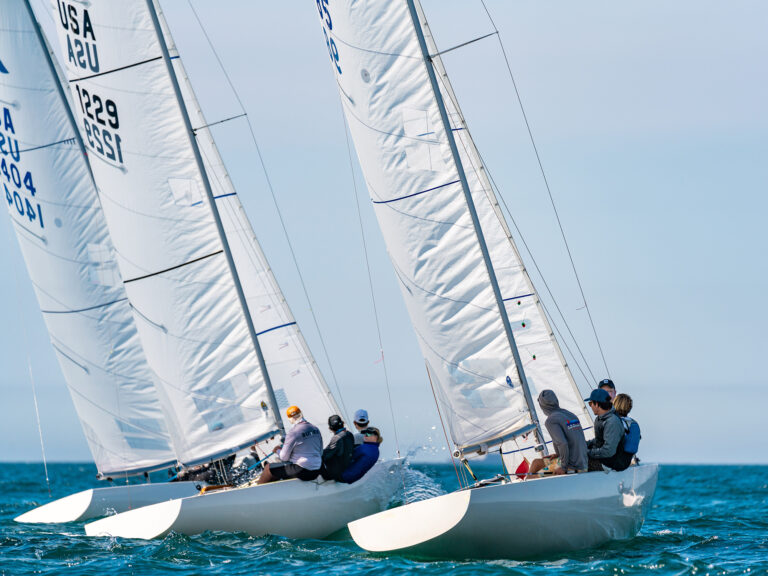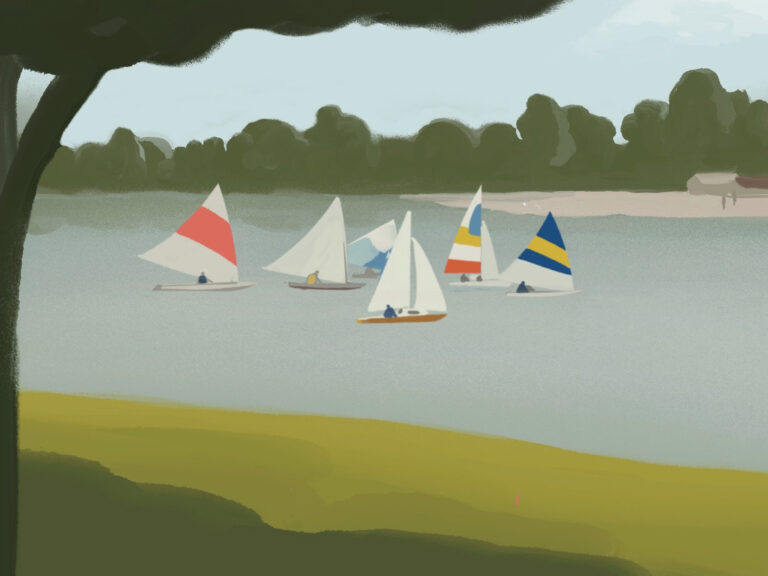“You got to lean on it,” cajoled Russell Coutts in his inimitable Kiwi staccato as we ripped downwind off Newport, R.I. “Come on, lean on it. My grandmother can lean on it harder than that.” I jabbed the wheel to leeward, the boat flattened out. “That’s too much. Bring it back up. It’s all about heel. Get her back up. Get her going. Now you’re too high. Lean on it, get her going.”
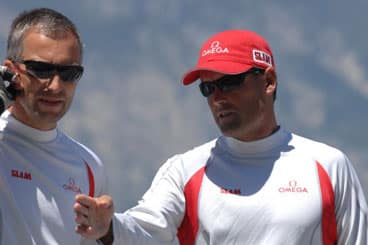
www.RC44.com| |**RC 44 designers Russell Coutts (right) and Andrej Justin produced a boat with few compromises and a lot of forethought. **|
It continued like that for another 3 minutes: me trying in vain to drive a pure thoroughbred through a gusty 15-knot westerly; the most successful America’s Cup sailor in history just a few feet away pointing out my seemingly inexhaustible supply of shortcomings when it came to helming his pride and joy, the stripped-down, muscled-up Russell Coutts 44.
As we closed in on harbor entrance, and the end of my brief career as a RC 44 helmsman, I finally got into something approximating a groove. The boat zipped along at 14 knots and 10 degrees of heel, skipping over the small wind-driven chop.
“All right,” said Coutts, just before he stole the wheel away for the third time in the last 15 minutes. “Another few hours and you just might become a racing sailor.” The professional crew burst with laughter.
The RC 44 is one hell of a boat. I expected a lot and, during our short sail, it delivered. It’s fast and challenging, a pure tool for the performance sailor. It’s a beast to sail. When I asked Jeff Brock, head trimmer for Team Aqua, which won the class’s overall championship in 2008, whether there was one position on the boat—most teams sail with 8 or 9—that was more important than the others, he shook his head. “All of them,” he said. “All of them.” And he wasn’t kidding. There’s no room for tourists on this machine. Two thirds of its 7,850-pound displacement—a Farr 40 weighs 10,900 pounds for comparison—is in the lead bulb. The hull has been stripped of everything that isn’t essential for buoy and match racing. There’s no interior. No berths, or galley, or head. No lifelines. The outboard leads are in the process of being removed. What there is on the boat, however, is just about everything that could make the boat faster and more rewarding to sail: A trim tab with 20-degrees of rotation to each side, horizontal, floating jib tracks and floating leads, check stays, and a spinnaker retrieval system straight out of the America’s Cup. Upwind we did 7.8 comfortably, and 7.9 when I really focused. The sails were a little old, however, and 8.2, according to Coutts, is a more competitive number. Downwind, it takes off. We hit 15 knots without much fuss and last week, in Copenhagen, Coutts and Larry Ellison reportedly hit 25 knots in 30 knots of breeze (racing was cancelled that day).
It’s a boat that wants the riding crop, and not in small doses, nor with anything resembling tenderness. It wants you to leave nasty raw welts on its topsides. It likes it rough, and wet…OK, I better stop there. Hopefully you get the picture. At one point, I asked Andy Estcourt, the main trimmer, whether there was any windspeed below which they soaked low and rotated the spinnaker to windward, common practice on most sprit boats, even Melges 24s in very light air. He looked at me as if I had two heads. This boat is always sailed with leeward heel downwind. If it’s not there, you’re going backwards.
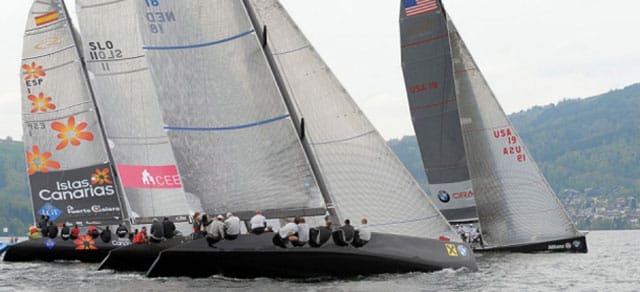
Gepa/Ralph Martin/www.RC44.com **| |Growth has been slow, but steady for the RC 44, which is now poised to bring its brand of high-intensity racing to the United States. **|
Coutts and co-designer Andrej Justin put as much effort into how the boat will work on land as they did its on-the-water performance. The boat comes in it’s own container-compatible cradle. Setting up the boat takes a couple of days, breaking it down, just one. A crane is required only to step or de-step the rig and launch or retrieve the boat. Shipping is a snap, everything, including the two-piece carbon mast, fits into the container. Getting a boat from the factory in Hungary to the United States, according to class manager Bertrand Favre, costs just $12,000 Euro.
But as impressive as the boat was, that’s not what I remember most from the day. Rather it was Coutts. It was as if a switch were flicked when we boarded the boat. On land, he’s driven by the alternating current of the unsteady, politically charged waters of the America’s Cup, where a lot of information moves, little of it with any substance. Coutts isn’t as glib as longtime tactician Brad Butterworth, who can disarm just about any situation, or uncomfortable question, with his quick wit. Instead Coutts is quick to deflect, and spends so much time taking the high road it’s a wonder he doesn’t get altitude sickness. Personally, I found him a lot more interesting when he goes on the offensive during the last Cup campaign. But those occasions are far and few between
The switch started once we boarded the Protector RIB to ride out to the 44, which was doing laps between Newport, and Conanicut Island. He joked about the fit of the high-cut foul-weatuer trousers he slipped on—“A little feminine, don’t you think?”—and grilled North American class rep Dee Smith about the prospects from the morning’s demo sails. Once we stepped aboard the race boat, the transformation was complete. This was Direct Current Russell, who looks exactly like his AC counterpart, but sounds entirely different. He motioned to the reporter for ChallengeandAdventure.com, who’s largely confined to a wheelchair. “Let’s get you on board,” he said.
She pointed at herself, “Me?” she said, taken completely by surprise.
“Yeah,” said Coutts. “Do you want to?”
Of course she did. Who wouldn’t?
As soon as the sails were up, Coutts started ribbing everyone on the boat. When I took the wheel, he slid to where I’d been sitting in front of the mainsheet trimmer.
“OK,” he said to the crew draped over the side, Star-boat style, only without the harness and the hiking straps. “Let me show you how this done.” He craned outward. “Look at this old Finn sailor. Still got it.”
He didn’t, but that hardly mattered.
After a tack, he took over the mainsheet. “Do you want some gloves?” Estcourt asked
He laughed. “Gloves are for pansies,” he said, then without missing a beat. “Alright, now that we’ve got a real mainsheet trimmer, we’ll see what we can do.”
He eventually gave the mainsheet back and focused his energy on critiquing my performance at the wheel. Unlike he previous targets, I gave him plenty to work with.
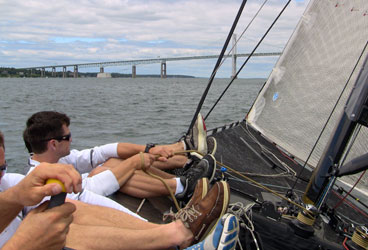
Stuart Streuli| |**It’s not as tough as it looks says trimmer Jeff Brock, of the hiking on the RC 44. I’m not so sure about that. Sailing the RC 44 is not for the faint of heart (or forearms). It’s a challenging boat that rewards strength and skill with outstanding performance. **|
He stole the wheel for the set, then handed it back as we hauled the mail downwind. Before I felt the boat slow, he was telling me to head up. Before the sail luffed or the boat loaded up, he was telling me to head down. He was unrelenting. Sailing is such a difficult sport to quantify. Yet here was Coutts, showing me exactly how little I know about making a boat of this caliber go fast. It was as if he was operating 20 seconds into the future. I never had a chance.
After an hour of sailing, it was time to head back to the dock. “I’ll leave you boys to it,” said Coutts, referring to the de-rigging of the boat. “Somebody’s got to do the dirty work.”
He, of course, employed the expected flavor of sarcasm when you leave others to handle the gritty manual labor of breaking down a 44-foot boat while you head off to yet another business lunch. But I get the sense that there’s a part of Coutts—and not an insignificant one either—that would’ve been perfectly happy just to keep sailing; to leave the schmoozing and selling to someone else. The boat is tangible version of how Coutts envisions the sport of sailing and there is little he’d rather than spend some time finding its limits.


